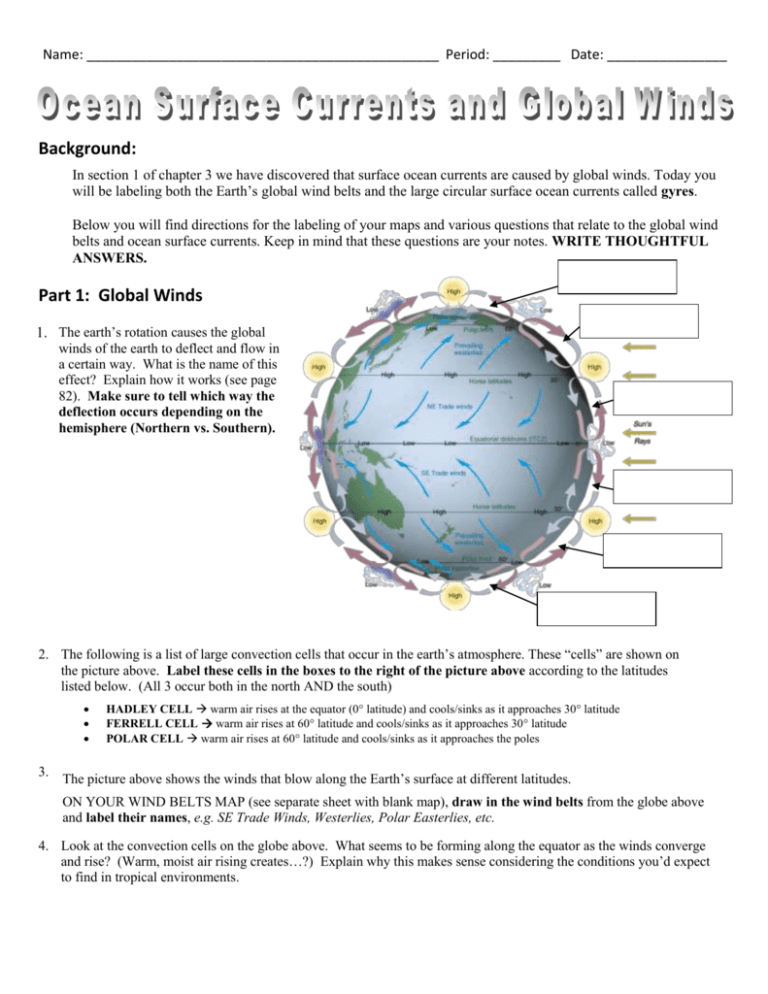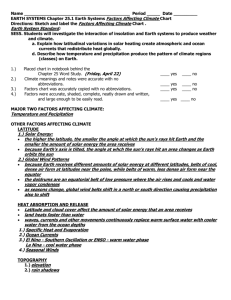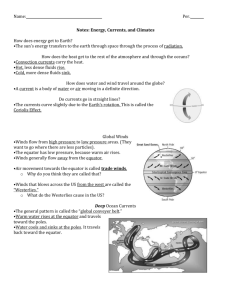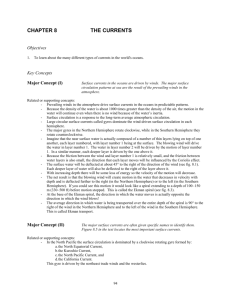Ocean Currents & Global Winds Worksheet: High School
advertisement

Name: _______________________________________________ Period: _________ Date: ________________ Background: In section 1 of chapter 3 we have discovered that surface ocean currents are caused by global winds. Today you will be labeling both the Earth’s global wind belts and the large circular surface ocean currents called gyres. Below you will find directions for the labeling of your maps and various questions that relate to the global wind belts and ocean surface currents. Keep in mind that these questions are your notes. WRITE THOUGHTFUL ANSWERS. Part 1: Global Winds 1. The earth’s rotation causes the global winds of the earth to deflect and flow in a certain way. What is the name of this effect? Explain how it works (see page 82). Make sure to tell which way the deflection occurs depending on the hemisphere (Northern vs. Southern). 2. The following is a list of large convection cells that occur in the earth’s atmosphere. These “cells” are shown on the picture above. Label these cells in the boxes to the right of the picture above according to the latitudes listed below. (All 3 occur both in the north AND the south) 3. HADLEY CELL warm air rises at the equator (0 latitude) and cools/sinks as it approaches 30 latitude FERRELL CELL warm air rises at 60 latitude and cools/sinks as it approaches 30 latitude POLAR CELL warm air rises at 60 latitude and cools/sinks as it approaches the poles The picture above shows the winds that blow along the Earth’s surface at different latitudes. ON YOUR WIND BELTS MAP (see separate sheet with blank map), draw in the wind belts from the globe above and label their names, e.g. SE Trade Winds, Westerlies, Polar Easterlies, etc. 4. Look at the convection cells on the globe above. What seems to be forming along the equator as the winds converge and rise? (Warm, moist air rising creates…?) Explain why this makes sense considering the conditions you’d expect to find in tropical environments. Part 2: Surface Currents 5. What is a surface current? What three factors control the flow of surface currents? (see page 81) 6. Large circular surface currents of water within the ocean are called ocean gyres. Using the map on the other side of your global winds map, label the 5 main ocean gyres listed below. While your book does not name the gyres, you can see them in Figure 6. Draw the warm currents red and the colder currents blue. North Atlantic Gyre South Atlantic Gyre North Pacific Gyre South Pacific Gyre Indian Ocean Gyre 7. On this same map, label the names of just the four currents associated with the North Atlantic Gyre. 8. What is a deep ocean current? 9. Use the table below to summarize the three different ways deep ocean currents form. Explain these factors IN YOUR OWN WORDS. (see Figure 7 on p. 84) 10. Explain how and why water at the surface near the North Pole (in the Atlantic) would begin to sink. (see Figure 8) 11. What eventually happens to the water that sinks at the poles? Where does it end up and WHY? Wind Belts Map Name: ______________________________________________ Period: _______ Date: _________________ Surface Currents Map









